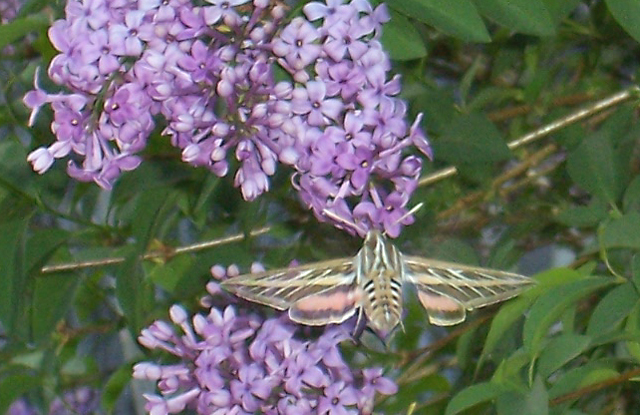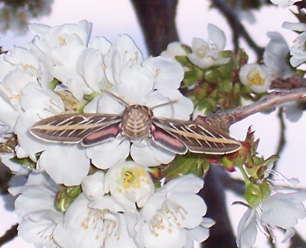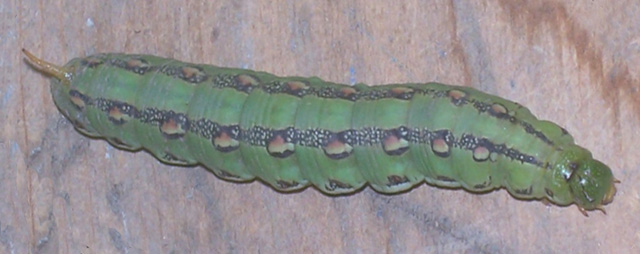Sphinginae subfamily
Sphingini tribe:
 |
This species has not been reported in Inyo County, but may be
there as a very rare stray. The moth is a very
strong flier and is frequently encountered far north of its usual range.
|
 |
This large bodied moth flies in tobacco fields and vegetable gardens
(potatoes, tomatoes) and wherever host plants are found. |
 |
This species is not recorded in Inyo
County, but it has been reported in neighbouring counties.
If you grow tomatoes, you have probably encountered it.
Larvae get very large and can strip a tomato plant. |
 |
Sphinx chersis
USGS, the Northern Ash
Sphinx or Great Ash Sphinx
The upperside of the forewing is soft dark-gray to blue-gray with
a series of black dashes, one reaching the wing tip. Note grey
thorax with narrow black lines.
|
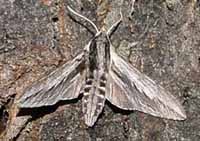 | Sphinx dollii (Wing span: 1 3/4 - 2 1/2 inches (4.5 - 6.3 cm)),
flies in arid brushlands and desert foothills from Nevada and
southern California east through Utah,
Arizona, Colorado, and New Mexico to Oklahoma and Texas. (possibly in eastern Inyo Co.)
|
 |
Forewings, long and slender, are held close to the body when the moth
is at rest. (northern if present)
I only see them occasionally on P.E.I. despite visiting lights
frequently. |
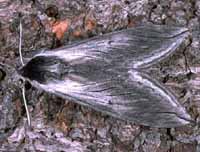 |
Sphinx perelegans adults fly in montane woodlands and mixed chaparral-type vegetation as a single brood
in the north, with adults mainly on the wing in June and July.
It flies from dusk until after midnight. Note dark thorax. |
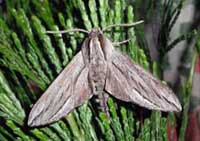 |
Sphinx sequoiae
WOQuestionable, the Sequoiae Sphinx
This species is not recorded in Inyo.
Adults fly as a single brood in the desert and in pinyon-juniper
woodland from May to August. |
 |
Sphinx vashti
USGS, the Snowberry Sphinx
The upperside of the forewing has a narrow black subterminal line
bordered by a white inverted V-shaped line on the outside, and a
black line running inwards from the apex of the wing.
It is most often found in montane woodlands and along streamcourses.
|
Smerinthini Tribe:
 |
This one is quite similar to Pachysphinx modesta, with modesta
being smaller and darker.
Moths should be on the wing from June-August.
|
Pachysphinx occidentalis, Bishop, California, 4000', June 30, 2010, Annette Switzer
 |
Smerinthus cerisyi
USGS, the Cerisyi's
Sphinx or One-eyed Sphinx, Larvae feed on poplars and willows.
Flight would be from late May-July as a single brood.
|
 |
Paonias myops USGS,
the Small-eyed Sphinx
This small species is present in Inyo County. This species ranges across North
America.
The hindwings have a small blue eyespot ringed with black on a yellow
background.
|
Macroglossinae subfamily
Dilophonotini Tribe:
 |
The abdomen has very distinct gray and black bands.
Adults nectar at dusk so you may see them in the garden at that time. |
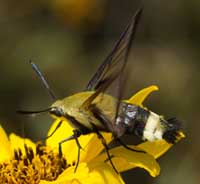 |
Hemaris thetis USGS, the Thetis Clearwing or Bee Hawk Moth,
The moth flies along forest edges and in meadows, gardens and
brushy fields. Day-flying adults nectar at lantana, dwarf bush honeysuckle,
snowberry, orange hawkweed, thistles, lilac, Canada violet, etc.
|
Philampelini Tribe:
 |
Adults nectar from flowers of Japanese honeysuckle
(Lonicera japonica), petunia (Petunia hybrida),
mock orange (Philadelphus coronarius), and phlox (Phlox).
Fight would be from June to August. Larvae feed on grape foliage.
|
Eumorpha achemon
May 29, 2008, courtesy of Ruth Nielsen
Macroglossini Tribe:
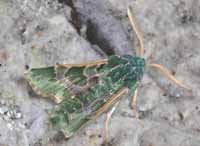 |
Arctonotus lucidus
WO, the Pacific Green
Sphinx Moth or Bear SphinxThis species is not confirmed in Inyo
County (probably western if present). It tends to be an late winter-early spring flier, on the
wing in the early evening. It comes to lights at night. |
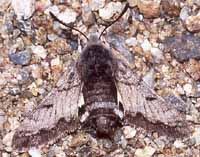 |
Euproserpinus phaeton,
the Phaeton Primrose Sphinx, WO see below
Adults nectar at flowers during the warm parts of the day.
Euproserpinus phaeton adults fly swiftly and close to the ground over
dry washes and flat areas in deserts as a single brood from
February-April.
|
 |
Hyles lineata
RN,
the White-lined Sphinx
Adults usually fly at dusk, during the night, at dawn, and during the
day. Moths nectar at a number of different flowers and oviposit on
Epilobium cana (California fuchsia) and
Hooker's Evening Primrose. |
Hyles lineata, April 14, 2006, Ruth Nielsen.
Hyles lineata, April 3, 2007, Ruth Nielsen.
Hyles lineata, April 4, 2008, Ruth Nielsen.
Hyles lineata, May 29, 2008, Ruth Nielsen.
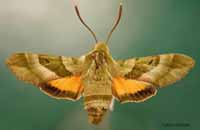 |
Adults fly in the afternoon from April-June in oak woodland and
pine-oak woodland in foothills, nectaring from chia, heartleaf
milkweed, golden currant, bluedicks, fairyfans, vetches,
thistles, hedgenettles, etc. |
|
|
